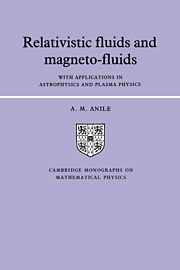Book contents
- Frontmatter
- Contents
- Preface
- 1 Introduction
- 2 Mathematical structure
- 3 Singular hypersurfaces in space-time
- 4 Propagation of weak discontinuities
- 5 Relativistic simple waves
- 6 Relativistic geometrical optics
- 7 Relativistic asymptotic waves
- 8 Relativistic shock waves
- 9 Propagation of relativistic shock waves
- 10 Stability of relativistic shock waves
- References
- Index
7 - Relativistic asymptotic waves
Published online by Cambridge University Press: 06 January 2010
- Frontmatter
- Contents
- Preface
- 1 Introduction
- 2 Mathematical structure
- 3 Singular hypersurfaces in space-time
- 4 Propagation of weak discontinuities
- 5 Relativistic simple waves
- 6 Relativistic geometrical optics
- 7 Relativistic asymptotic waves
- 8 Relativistic shock waves
- 9 Propagation of relativistic shock waves
- 10 Stability of relativistic shock waves
- References
- Index
Summary
Introduction
One of the most useful perturbation methods for dealing with nonlinear waves is that of asymptotic and approximate waves, which is a fruitful extension of the high-frequency method of the linear theory. In its full generality, for arbitrary quasi-linear systems, the method has been developed by Choquet–Bruhat in a series of articles (Choquet–Bruhat, 1969a, 1969b, 1973) where applications to relativistic fluid dynamics, to Einstein's equations in vacuo, and to the Einstein–Maxwell system are also presented. Further applications have considered the Einstein equations coupled with a scalar field (Choquet–Bruhat and Taub, 1977), relativistic cosmology (Anile, 1977), relativistic magneto-fluid dynamics (Anile and Greco, 1978), and supergravity theory (Choquet–Bruhat and Greco, 1983).
A different but substantially equivalent approach is that of the averaged Lagrangian, originally due to Whitham (1974). Extensions of the averaged Lagrangian approach to the relativistic framework have been made, among others, by Dougherty (1970; 1974), Dewar (1977), and Achterberg (1983) for relativistic plasmas and by MacCallum and Taub (1973), Taub (1978), and de Arajuro (1986) for gravitational waves in vacuo.
The method of asymptotic waves is potentially relevant for several problems in relativistic astrophysics and plasma physics. In Chapter 5 we studied the nonlinear evolution of a simple wave. In many situations one deals with waves which cannot be considered as simple waves (for instance, a pulse propagating down a density gradient). In these cases, in general, the only way by which the nonlinear evolution can be studied is by means of perturbation methods.
- Type
- Chapter
- Information
- Relativistic Fluids and Magneto-fluidsWith Applications in Astrophysics and Plasma Physics, pp. 188 - 210Publisher: Cambridge University PressPrint publication year: 1990

